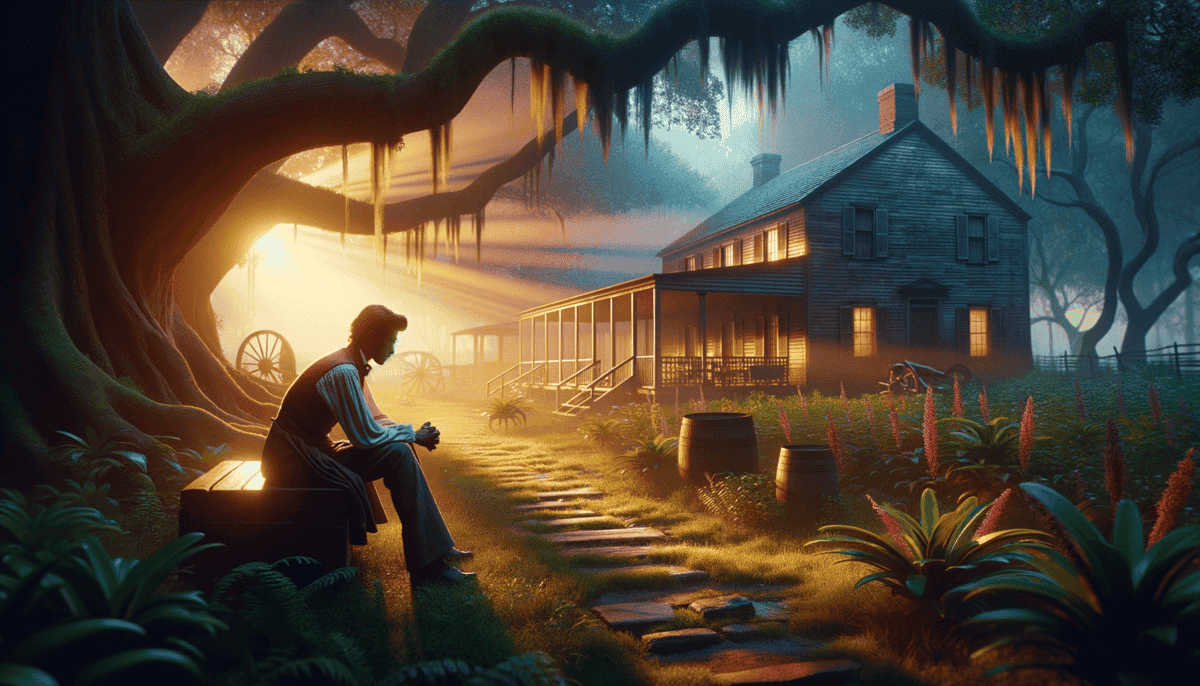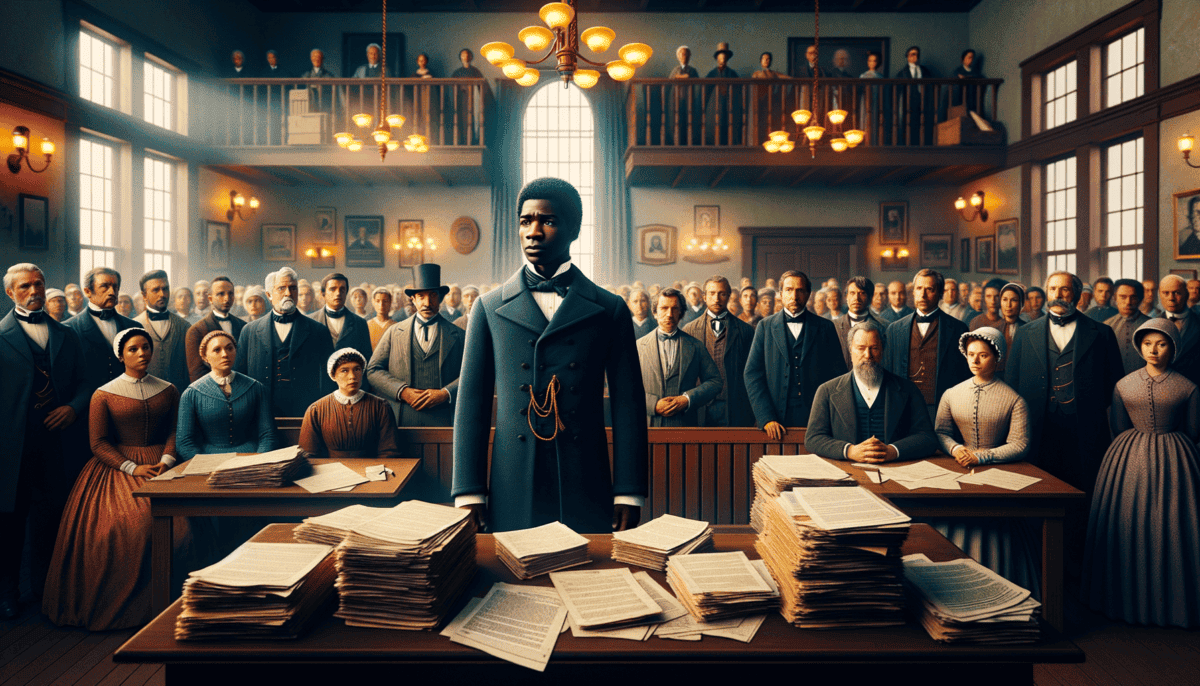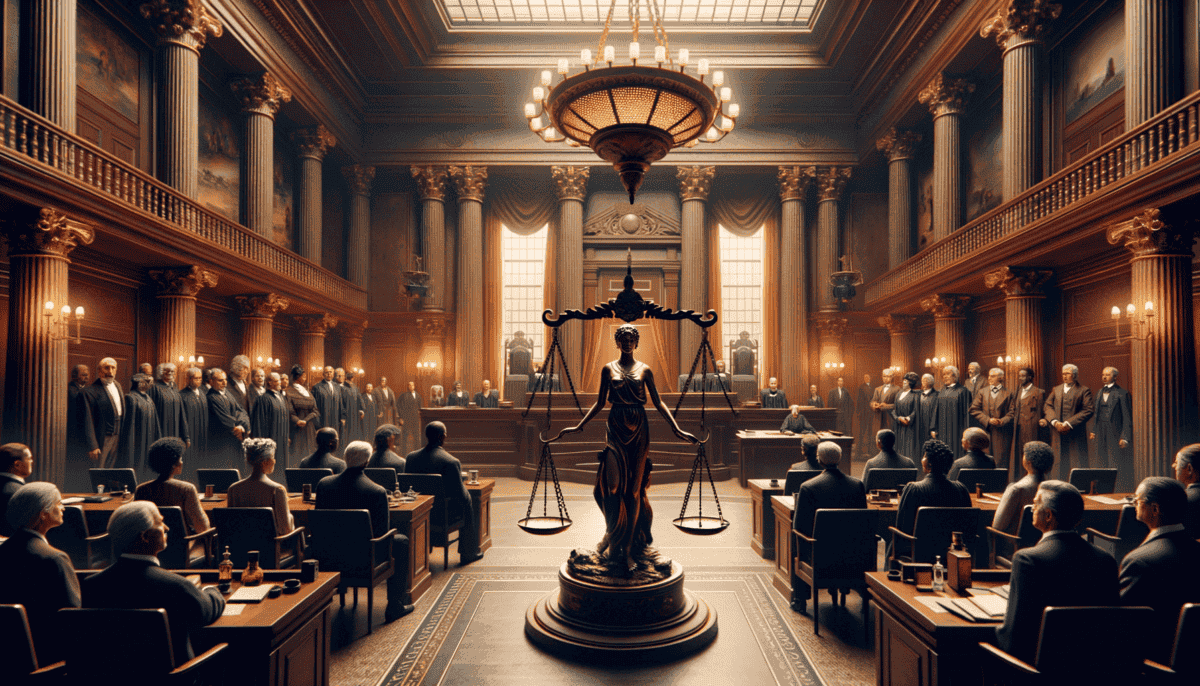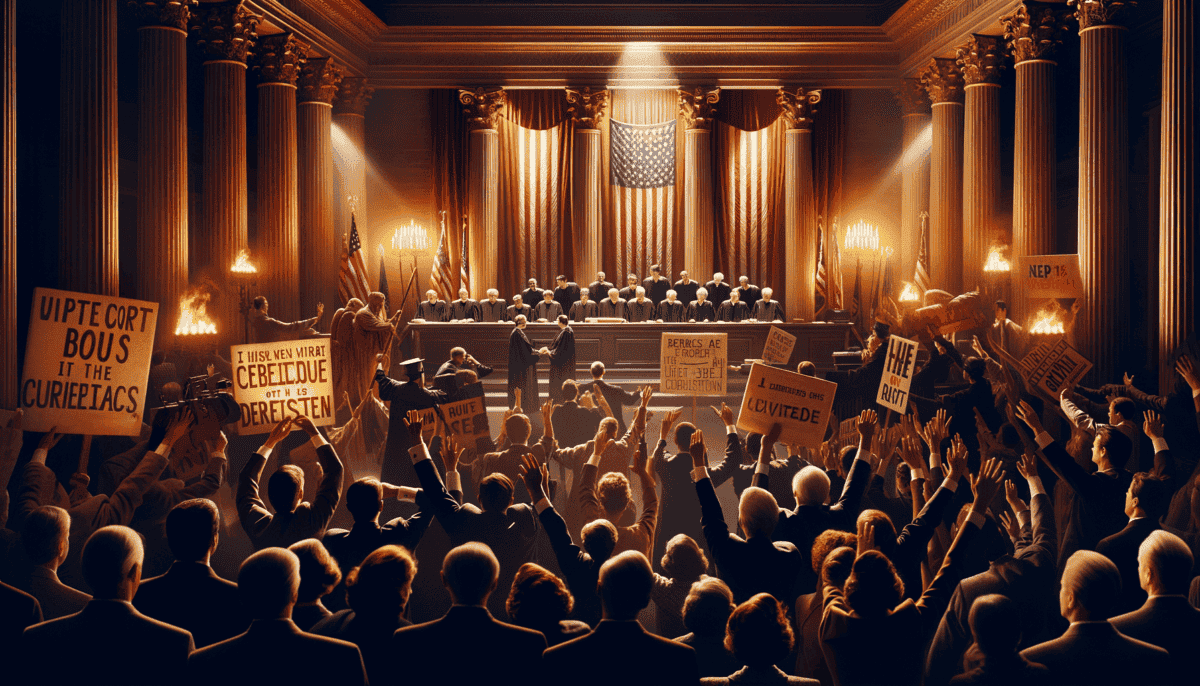A Dream of Freedom
The morning sun peeked through the trees as Dred Scott looked across the Missouri fields. He was tired from working, but hope filled his heart.
"One day," he whispered to himself, "I will be free."
Dred was born in Virginia around 1799. Like many enslaved people, he didn't know his exact birthday. But he did know one important thing – he wanted to be free.
Life as an Enslaved Person
Living as an enslaved person was very hard. Dred had to work long hours in the fields. He couldn't choose where to live or what work to do. Most importantly, he couldn't be with his family whenever he wanted.
“The hardest part wasn’t the work,” Dred would later tell his friends. “It was not being able to make choices for myself and my family.”
In 1830, something big happened in Dred's life. He was sold to a doctor named John Emerson. Dr. Emerson took Dred to live in free states like Illinois, where slavery was not allowed. This gave Dred an idea that would change history.
A Family’s Hope
While working for Dr. Emerson, Dred met and fell in love with Harriet Robinson. They got married and had two beautiful daughters. Dred wanted his family to be free more than anything in the world.
"Papa," his younger daughter asked one evening, "will we always be enslaved?"
Dred hugged her tight. "No, my sweet child. I promise I will find a way to make us free."
The Big Decision
In 1843, Dr. Emerson died. Dred thought this might be his chance for freedom. He offered to buy his family's freedom from Dr. Emerson's widow, but she said no.
That's when Dred made the bravest decision of his life. He decided to go to court and ask for his freedom. This was very dangerous. Many enslaved people who tried to get their freedom through courts were punished.
Harriet held his hand tightly. "Are you sure about this, Dred?"
"Yes," he answered firmly. "For our daughters, for us, for all people who dream of freedom – we must try."
The sun was setting now, painting the Missouri sky in beautiful colors. Dred Scott stood tall, knowing that tomorrow would bring the beginning of a long fight for freedom. He didn't know it yet, but his brave decision would help change America forever.
Little did he know that his simple wish for freedom would lead to one of the most important court cases in American history. As night fell over Missouri, Dred Scott's dream of freedom was just beginning to take shape.
Justice on Trial
The courthouse in St. Louis looked huge to Dred Scott. Its tall stone columns reached up to the sky like giant trees. ️ It was April 1846, and Dred was about to do something very brave.
The First Step
“Are you scared, Papa?” whispered his daughter Eliza, squeezing his hand.
“A little,” Dred answered honestly. “But sometimes we must be brave even when we’re scared.”
Making Their Case
Dred’s lawyers had a simple argument. They said that because Dr. Emerson had taken Dred to live in free places like Illinois and Wisconsin, Dred should be free. In these places, slavery was not allowed.
“If a person lives in a free state, they become free,” explained Taylor Blow, one of Dred’s helpful friends. “That’s what the law says.”
But Mrs. Emerson’s lawyers disagreed. They said Dred was still enslaved, no matter where he had lived before.
A Family’s Wait
The court case took a long time. Harriet and the children waited and hoped. Sometimes they would sit together in their small home and talk about what freedom would be like.
“When we’re free,” young Lizzie would say, “I want to go to school!”
“And I want to learn to read,” added Harriet with a smile.
Hard Times
The first trial didn’t go well. The judge said Dred and his family had to stay enslaved. But Dred didn’t give up!
“We’ll try again,” he told his family. “As long as we have hope, we keep fighting.”
Many people helped Dred and his family during this time. Some gave them food. Others gave money to pay the lawyers. Even some white people who didn’t like slavery helped them.
A Growing Storm
The case was getting attention all over Missouri. Some people supported Dred, while others got angry about it. The newspaper wrote stories about the case. More and more people started talking about whether slavery was right or wrong.
| People Who Helped | How They Helped |
| Lawyers | Worked for free to help Dred |
| Friends | Gave food and money |
| Abolitionists | Spoke up for Dred’s freedom |
One evening, as Dred sat with his family, a friend came with news. The case would go to a bigger court. This meant another chance for freedom!
“What happens now, Papa?” asked Eliza.
“Now,” said Dred, hugging his daughter, “we keep hoping and praying. Our fight for freedom is just beginning.”
The sun set over St. Louis that evening, and the Scott family held each other close. They didn’t know their simple fight for freedom would soon become one of the biggest court cases in American history.
The Fight Grows Bigger
The year was 1850, and Dred Scott’s case was moving to a bigger court. More people were talking about it every day.
Moving Up
Dred and Harriet sat in their small home, reading a letter from their lawyer.
“What does it say, Papa?” asked little Lizzie, peering over his shoulder.
“The Missouri Supreme Court will hear our case,” Dred explained with a smile. “That’s the biggest court in our state!”
A Growing Battle
People all over Missouri were picking sides. Some wanted Dred to win his freedom. Others got very angry about it.
“Your case is helping people understand why slavery is wrong,” said Roswell Field, Dred’s new lawyer. “You’re fighting for every enslaved person.”
The newspapers wrote more stories about Dred. Some were nice, and some were mean. But Dred stayed strong.
Family Strong
Life wasn’t easy while they waited. Harriet worked hard to keep the children’s hopes up.
“Mama, are we going to be free soon?” Eliza asked one night.
“We must be patient,” Harriet answered, braiding her daughter’s hair. “Good things take time.”
Big Arguments
In the courtroom, the lawyers made their cases. Dred’s lawyer said something very important:
| Dred’s Side Said | The Other Side Said |
| Living in free states makes you free | Slaves stay slaves everywhere |
| Everyone deserves freedom | Slaves are property |
A Country Divided
The case was making people argue about slavery all over America. Some states wanted to keep slavery, and others wanted to end it. ️
“Your case is like a tiny spark,” Taylor Blow told Dred. “It’s starting a big fire of change.”
Waiting for News
Days turned into weeks as everyone waited for the judges to decide. Dred kept working. Harriet kept caring for the children. They tried to live normally, but it wasn’t easy.
One day, a group of friendly neighbors brought them food and supplies. They sang songs together and shared stories. It helped make the waiting easier.
Hope Stays Alive
Even when things looked hard, Dred didn’t lose hope. He knew his fight was important.
“We’re not just fighting for us anymore,” he told his family one evening. “We’re fighting for everyone who dreams of freedom.”
As summer turned to fall, the Scott family waited for news from the big court. They didn’t know their case would soon go even higher – all the way to Washington, D.C., where the most important judges in America would hear their story. ️
The Highest Court
The big day had finally come. Dred Scott’s case was now at the Supreme Court in Washington, D.C. This was the most important court in America! ️
A Special Judge
Chief Justice Roger B. Taney led the Supreme Court. He sat in the middle of eight other judges. They all wore black robes.
“The court looks like a castle,” whispered Lizzie to her mama. They had traveled far to watch the case.
Making Their Case
Montgomery Blair, Dred’s new lawyer, stood up to speak. He talked about freedom and fairness. ⚖️
“Dred Scott lived in free places,” Blair said. “That makes him free!”
The other side’s lawyer disagreed. “Slaves are property,” he argued. “They can’t be citizens.”
Hard Questions
The judges asked many questions. Some seemed friendly, others didn’t.
“Can a slave become free by going to a free state?” asked one judge.
Blair answered, “Yes! That’s what our laws say.”
Waiting Again
After the lawyers finished talking, everyone had to wait. The judges needed time to think about their decision.
“How long will it take?” asked Eliza.
“Nobody knows,” Harriet answered. “We must be patient.”
The Big Day
On March 6, 1857, Chief Justice Taney stood up to read the decision. The room was very quiet.
His words were shocking:
| The Court Said | This Meant |
| African Americans were not citizens | They couldn’t use the courts |
| Congress couldn’t ban slavery in territories | Slavery could spread to new places |
Sad News
Dred and his family were very sad. They had lost their case.
“What do we do now?” Lizzie asked, holding her father’s hand.
“We stay strong,” Dred answered. “Sometimes doing the right thing means losing battles but not giving up.”
More Than Just One Case
The decision made many people angry. People who didn’t like slavery said it was wrong.
“This isn’t just about Dred Scott anymore,” said one newspaper. “It’s about what kind of country we want to be.”
All across America, people started talking more about slavery. Some states got very angry at other states. The country felt like it was splitting apart. ️
As Dred and his family left Washington, they didn’t know their case would change America forever. The fight for freedom was getting bigger, and soon the whole country would have to choose which side it was on.
A Nation Divided
News of the Dred Scott decision spread across America like wildfire! People everywhere had strong feelings about what the Supreme Court said.
Different Views
In the North, people were very angry. Frederick Douglass, a famous person who used to be enslaved, spoke to a big crowd.
“This decision is wrong! All people deserve to be free!” Douglass said with a strong voice.
But in the South, many people were happy. They had parties to celebrate.
Newspaper Stories
Every newspaper wrote about Dred Scott. Some were mad, others were glad.
“This decision will tear our country apart!” wrote one Northern paper.
“The Court is right – slaves are property!” said a Southern paper.
Friends Become Enemies
The fight about slavery got bigger. People who were once friends stopped talking to each other.
Little Tommy from Boston wrote to his cousin Sarah in Virginia:
Why does your family think slavery is okay? My papa says it’s very wrong.
Your cousin,
Tommy”
New Leaders Speak Up
A tall lawyer named Abraham Lincoln started giving speeches about the decision. He didn’t like what the Supreme Court said.
“No one should own another person,” Lincoln said. “It goes against what America stands for!”
| The North Wanted | The South Wanted |
| To end slavery | To keep slavery |
| Changes to laws | Things to stay the same |
Getting Ready to Fight
Some people started talking about war. Both sides began getting ready, just in case. ⚔️
Changes for Dred
Even though Dred Scott lost his case, something good happened. His new owner set him free! ️
“We are finally free,” Dred told his family with happy tears.
But Dred knew his case had started something bigger. The whole country was arguing about slavery now.
Growing Trouble
More and more people picked sides. They had strong feelings about slavery:
- Some states threatened to leave America
- People stopped doing business with each other
- Churches split into Northern and Southern groups
- New states had to choose if they would allow slavery
The country felt like a big family having a very bad fight. Nobody knew how to fix it.
As winter turned to spring in 1858, dark clouds were gathering over America. The fight about slavery was getting worse, and soon the country would face its biggest test ever.
Standing Up for What’s Right
The year was 1858, and America was changing fast! The Dred Scott decision had started something big that would change our country forever.
A Free Man At Last
Even though he lost his big court case, Dred Scott was finally free! His new owner, Mrs. Calvin Chaffee, gave him his freedom papers.
“I may have lost in court, but I won my freedom,” Dred told his daughter Lizzie with a smile.
Saying Goodbye
Sadly, Dred Scott got very sick in 1858. Before he died, he shared wise words with his family.
“We fought for what was right,” he told them. “Always stand up for what you believe in.”
Big Changes Coming
The fight about slavery got bigger and bigger. A new president named Abraham Lincoln was elected in 1860.
The Country Splits Apart
Some states were so angry they left America! They made their own country called the Confederate States.
| Before the Split | After the Split |
| One United States | Two separate countries |
The Civil War
In 1861, the Civil War began. It was the biggest fight America ever had. ⚔️
Freedom Wins
After the war, three new rules were added to America’s big rule book:
- Slavery was ended forever
- Black people became citizens
- Everyone got the right to vote
Dred Scott’s Big Dream
Even though Dred Scott didn’t live to see it, his dream came true! His fight for freedom helped change America.
“Dred Scott was brave,” people said. “He showed us that fighting for what’s right is important.”
Learning from the Past
Today, we remember Dred Scott’s story to learn important lessons:
– Be brave like Dred Scott
– Stand up for what’s right
– Never give up hope
– Every person matters
Dred Scott’s fight for freedom helped make America better. His story shows us that one person can make a big difference!
The Supreme Court made a big mistake in the Dred Scott case. But brave people kept fighting for what was right. Their hard work made our country stronger and fairer for everyone.
When we see something wrong today, we can be brave like Dred Scott. We can speak up and help make things better. That’s how we keep making America a place where everyone is free and equal!






